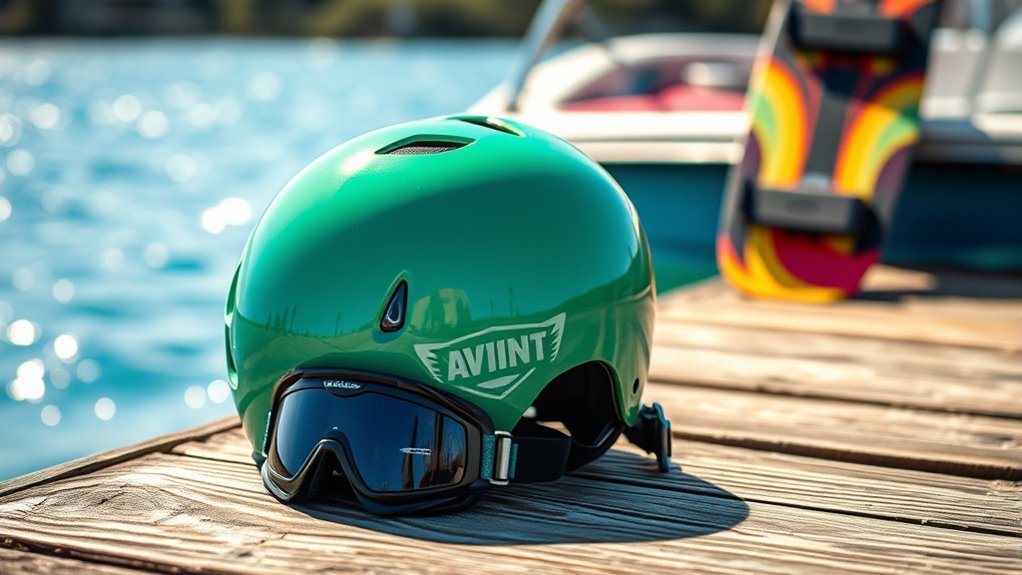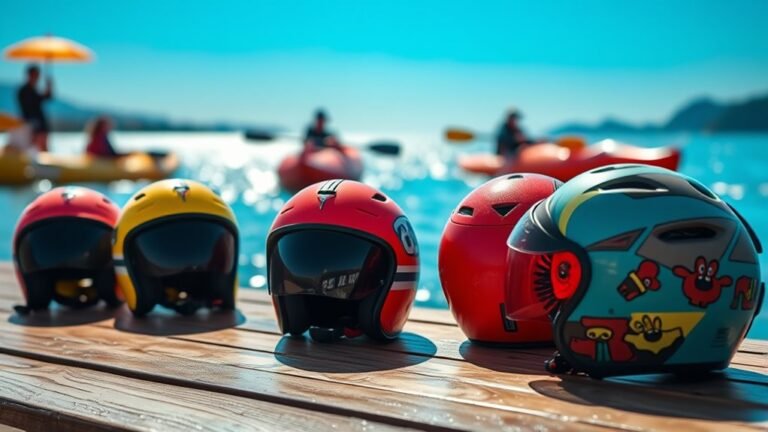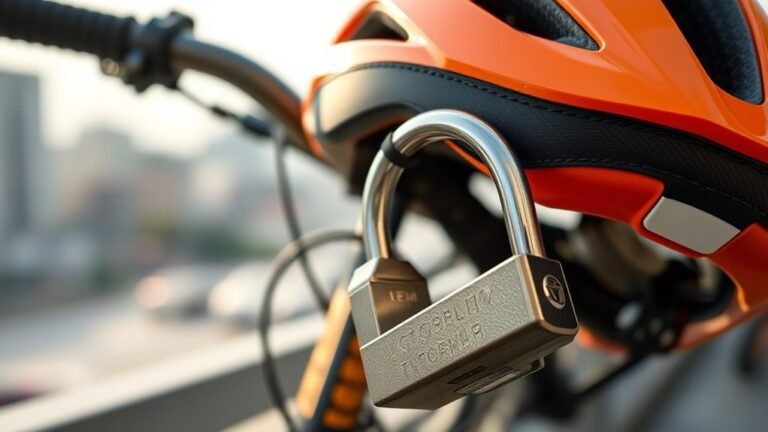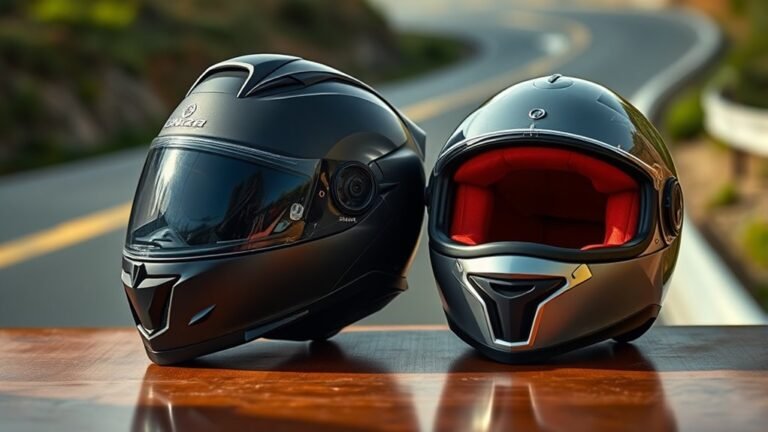The Importance of Helmet Fit for Water Sports
A properly fitting helmet is essential for your safety in water sports, as it guarantees effective protection against head injuries. An ill-fitting helmet can shift during impact, increasing risk and distraction. Key features to take into account include lightweight materials, impact resistance, and adjustable straps for a secure fit. Additionally, ventilation plays a role in maintaining comfort. Understanding these aspects can enhance your performance and safety on the water, with more insights available on fitting and features.
Understanding the Risks of Water Sports
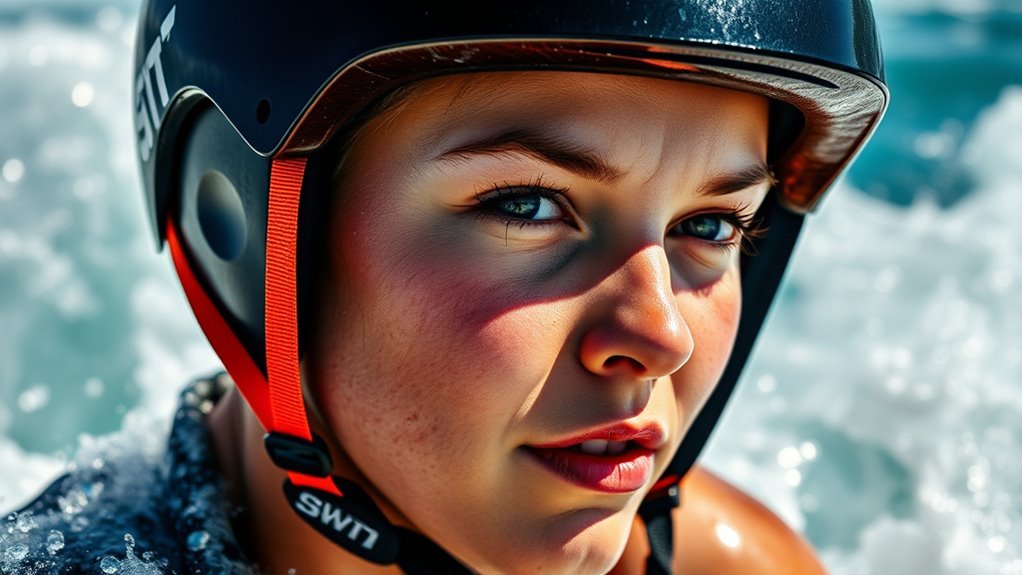
When participating in water sports, understanding the inherent risks is essential for ensuring your safety. Conducting a thorough risk assessment helps you identify potential hazards, such as strong currents, sharp objects, or equipment failures. By recognizing these dangers, you can implement effective safety measures tailored to your activity. For instance, wearing a life jacket, utilizing appropriate gear, and ensuring your equipment is in good condition can considerably reduce risks. Additionally, familiarize yourself with local water conditions and regulations to stay informed. Always consider your skill level and don’t push beyond your limits. Embracing the freedom of water sports doesn’t mean ignoring safety; instead, it involves balancing adventure with responsibility to protect yourself and others while enjoying the thrill.
How a Helmet Protects You
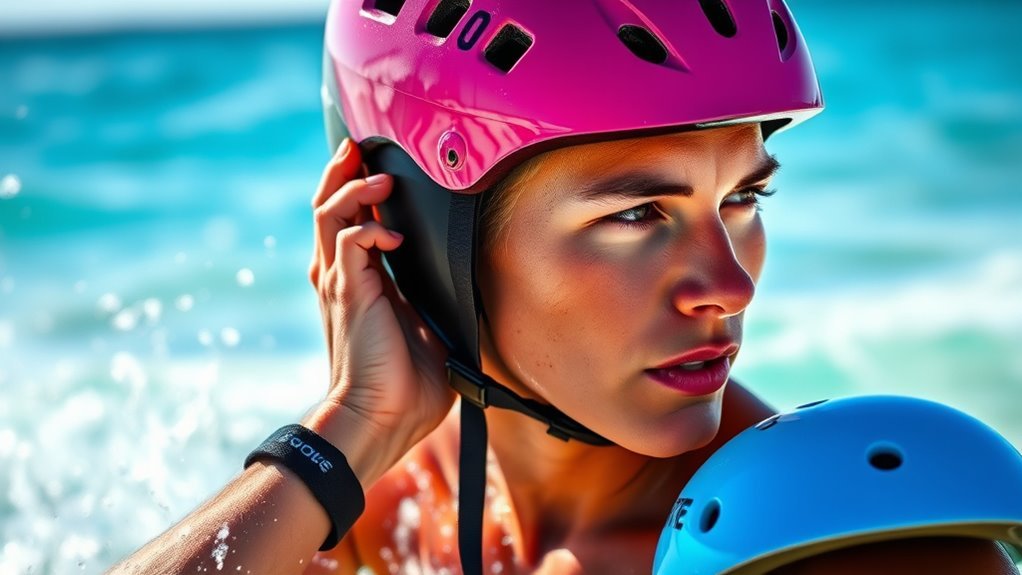
While engaging in water sports, wearing a helmet can greatly enhance your safety by providing essential protection against head injuries. Modern helmet technology incorporates advanced materials and design features that absorb impact forces, reducing the risk of concussions and other serious injuries. These helmets are rigorously tested to meet safety standards, ensuring they can withstand the unique challenges posed by water activities. Features like inner foam padding and adjustable straps help create a secure fit, which is vital for peak performance. A well-fitted helmet not only safeguards your head but also grants you the freedom to enjoy your sport with confidence, knowing you’ve taken an important step toward protecting yourself. Prioritizing helmet safety helps you embrace the thrill of water sports responsibly.
The Impact of Ill-Fitting Helmets
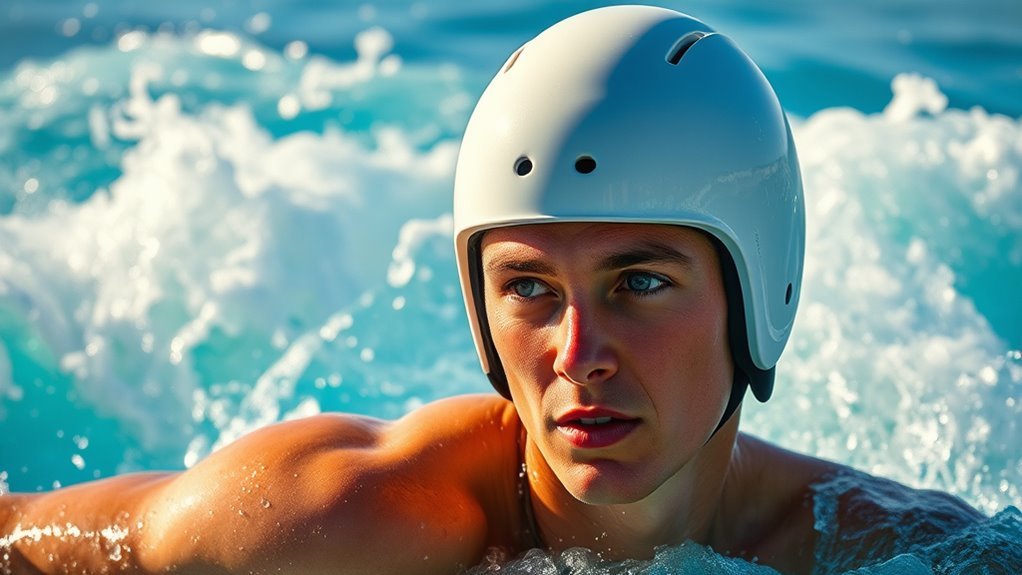
An ill-fitting helmet can compromise your safety during water sports, leading to serious consequences. When a helmet doesn’t fit properly, it can shift or come off entirely during impact, drastically reducing its protective capabilities. This lack of helmet safety heightens the risk of head injuries, which can result in long-term damage or even fatality. Furthermore, an uncomfortable helmet can distract you, detracting from your focus and freedom on the water. For effective injury prevention, it’s essential to confirm your helmet is snug yet comfortable, allowing you to enjoy your sport without fear. Remember, a well-fitted helmet is your first line of defense; don’t take unnecessary risks by neglecting this vital aspect of your safety gear.
Key Features to Look for in a Helmet
Choosing the right helmet for water sports involves understanding several key features that enhance safety and performance. You’ll want to focus on helmet materials that provide both durability and comfort. Look for lightweight yet robust options like polycarbonate or fiberglass, which offer excellent impact resistance.
Here’s a quick comparison of features to evaluate:
| Feature | Importance |
|---|---|
| Helmet Materials | Lightweight and durable |
| Impact Resistance | Protects against collisions |
| Ventilation | Keeps you cool during activity |
Measuring for the Perfect Fit
To guarantee a helmet provides ideal protection and comfort during water sports, measuring for the perfect fit is essential. Start with head measurement techniques, such as using a soft measuring tape to determine the circumference just above your eyebrows. Record the measurement in centimeters or inches. Next, consult the sizing chart guidelines specific to the helmet brand you’re interested in, as sizes can vary between manufacturers. Choose a helmet that corresponds to your head measurement, ensuring it’s snug but not overly tight. Remember, proper fit means the helmet should sit level on your head and feel secure without shifting during movement. Following these steps will help you enjoy your water sports with confidence and safety.
Types of Helmets for Different Water Sports
When selecting a helmet for water sports, it’s essential to match the helmet type to the activity you’re participating in. Kayaking and canoeing helmets are designed for impact protection in turbulent waters, while wakeboarding and waterskiing helmets focus on lightweight design and visibility. Surfing and paddleboarding helmets prioritize drainage and ventilation to keep you comfortable and safe in dynamic environments.
Kayaking and Canoeing Helmets
Whether you’re maneuvering calm lakes or tackling challenging whitewater rapids, selecting the right helmet for kayaking and canoeing is essential for safety and performance. Different helmet types cater to specific activities; a whitewater helmet typically features a hard shell for impact protection, while a touring helmet offers lightweight comfort for long-distance paddling. Both types utilize advanced helmet technology, ensuring a snug fit and ideal ventilation. For kayaking safety, it’s vital to assess your helmet’s fit, as even a small misalignment can compromise protection. Look for adjustable straps and padding that accommodate your head shape. Remember, a well-fitted helmet not only keeps you safe but enhances your freedom on the water, allowing you to focus on the thrill of your adventure.
Wakeboarding and Waterskiing Helmets
After guaranteeing your safety in kayaking and canoeing, it’s important to contemplate the right helmet for wakeboarding and waterskiing, where the dynamics of water and speed introduce different risks. When choosing helmets, prioritize those specifically designed for wakeboarding safety. Look for models with a snug fit, reinforced sides, and adequate padding. These helmets often feature a visor for sun protection and are lightweight for comfort during extended sessions. For waterskiing equipment, guarantee the helmet can withstand impacts, as falls can be frequent and forceful. Opt for adjustable straps to maintain a secure fit, as a loose helmet can compromise your safety. Ultimately, selecting the right helmet enhances your freedom to enjoy these exhilarating water sports.
Surfing and Paddleboarding Helmets
Choosing the right helmet for surfing and paddleboarding is essential for your safety out on the waves. Surfing safety hinges on selecting a helmet designed to withstand impacts while allowing for maximum visibility and ventilation. Look for lightweight options that fit snugly, ensuring they won’t shift during wipeouts.
For paddleboarding protection, consider helmets with additional coverage around the sides and back to guard against potential falls and collisions. There are specialized designs tailored for each sport, so choose one that suits your activity level and environment. Always prioritize a secure fit, as a helmet that’s too loose can compromise safety. With the right helmet, you can enjoy your freedom on the water, knowing you’re well-protected.
Adjusting Your Helmet for Maximum Comfort
To guarantee your helmet fits correctly for maximum comfort during water sports, it’s essential to make precise adjustments that accommodate your head shape and activity level. Start with the straps adjustment; make certain they’re snug but not overly tight, allowing for a secure fit without discomfort. When you fasten the chin strap, it should sit just below your jawline, providing stability without restricting movement. Next, consider padding considerations. The interior padding should conform to your head shape, filling any gaps that might cause pressure points. If the padding feels too thick or thin, replace it with the appropriate size. A well-adjusted helmet enhances your freedom on the water, making sure you stay focused on your adventure while remaining safely protected.
The Role of Ventilation in Helmet Fit
Ventilation plays an essential role in the overall fit of your helmet during water sports. Proper airflow enhances comfort levels by regulating temperature and managing moisture buildup. This guarantees that your helmet remains effective and pleasant to wear, even in demanding conditions.
Enhanced Comfort Levels
While you may prioritize safety when selecting a helmet for water sports, enhanced comfort levels, largely influenced by effective ventilation, are equally essential for an enjoyable experience. Proper ventilation allows for airflow, minimizing heat buildup and moisture retention, which can lead to discomfort during extended use. Comfort enhancements often include adjustable padding and fit adjustments that enable you to achieve a snug yet breathable fit. A well-ventilated helmet not only reduces distractions but also maintains focus on your performance, allowing you to enjoy the freedom of movement on the water. When choosing a helmet, consider how its design promotes airflow and comfort, ensuring you can engage in your favorite activities without feeling weighed down or overheated.
Temperature Regulation Benefits
Because maintaining an ideal temperature is essential during water sports, effective ventilation plays an important role in helmet fit. A well-ventilated helmet enhances temperature control, allowing heat to escape while enabling fresh air to circulate. This balance is vital for keeping you comfortable and focused on your performance. Proper airflow not only prevents overheating but also aids in sweat management, reducing the buildup of moisture that can lead to discomfort and distraction. When choosing a helmet, look for models with strategically placed vents that promote airflow without compromising safety. By ensuring your helmet fits correctly and ventilates effectively, you can enjoy your water adventures while staying cool and free to move with ease.
Moisture Management Features
Effective moisture management is essential for enhancing comfort during water sports, and the design of a helmet’s ventilation system plays a significant role in this aspect. A well-ventilated helmet promotes airflow, allowing moisture to escape and reducing the risk of sweat accumulation. Look for helmets featuring moisture-wicking liners that draw sweat away from your skin, enhancing overall sweat management. This not only keeps you dry but also helps maintain focus and performance by preventing distractions from discomfort. Additionally, strategically placed vents can optimize airflow, further improving temperature regulation. Choosing a helmet with effective moisture management features guarantees you stay comfortable and free to enjoy your time on the water without the hindrance of excessive moisture.
Maintenance Tips for Your Helmet
Proper maintenance of your helmet is essential to guarantee its longevity and safety. Start by employing effective cleaning techniques; use mild soap and water to gently scrub the exterior, while making sure you avoid harsh chemicals that could degrade materials. Rinse thoroughly and let it air dry completely. For the interior, check for moisture build-up and wipe it down with a damp cloth.
When it comes to storage solutions, keep your helmet in a cool, dry place away from direct sunlight, which can weaken the materials over time. Avoid placing heavy objects on top of it to maintain its shape. By following these maintenance tips, you can make certain your helmet remains in peak condition, ready for your next adventure on the water.
When to Replace Your Helmet
It’s crucial to know when to replace your helmet to guarantee maximum protection. Look for signs of damage, such as cracks or dents, and consider the age of your helmet, as materials can degrade over time. If you notice any of these issues, it’s time to invest in a new helmet for your safety during water sports.
Signs of Damage
While water sports helmets are designed to withstand significant impact, they aren’t indestructible; knowing the signs of damage is crucial for your safety. Start with a thorough crack inspection. Look for visible cracks or dents, especially around the shell and impact zones. Even small fractures can compromise the helmet’s integrity, so don’t overlook them. Next, assess the padding wear. If the internal padding feels compressed, is missing, or shows signs of degradation, it’s a clear indicator that the helmet’s protective capabilities have diminished. Regularly checking for these signs guarantees that your helmet remains effective. If you spot any damage or excessive wear, it’s time to replace your helmet; your safety in water sports should always come first.
Age of Helmet
Although a helmet may appear intact, its age can greatly impact its protective effectiveness. The helmet lifespan typically ranges from 3 to 5 years, depending on usage and helmet technology advancements. You should replace your helmet if it’s older than this, even if it seems fine.
Here’s a quick reference:
| Age of Helmet | Action Required |
|---|---|
| 0-3 Years | Inspect for damage |
| 3-5 Years | Consider replacement |
| 5+ Years | Replace immediately |
| After Impact | Replace immediately |
Staying informed about your helmet’s age guarantees maximum protection while enjoying your water sports. Don’t compromise your safety for freedom; a new helmet can enhance both.
Frequently Asked Questions
Can I Use a Bike Helmet for Water Sports?
You shouldn’t use a bike helmet for water sports. Bike helmets are designed to meet safety standards specific to cycling, focusing on impact resistance for falls on hard surfaces. Water sports helmets are engineered to handle different types of impacts, like hitting the water or obstacles. They also often feature drainage systems and are made from materials that perform better in wet conditions. Prioritize your safety by using the appropriate helmet for each activity.
What Materials Are Helmets Made From?
Helmets are typically made from durable materials like polycarbonate shells, which provide strong impact resistance and lightweight protection. Inside, you’ll find foam liners, designed to absorb shock and enhance comfort during use. These materials work together to guarantee your helmet can withstand impacts while keeping you comfortable, giving you the freedom to enjoy your activities without worry. Always choose a helmet that fits well to maximize the benefits of these materials.
How Do I Clean My Water Sports Helmet?
To clean your water sports helmet, start by removing any removable padding and rinse it with warm water. Use a mild soap solution to scrub the outer shell and inner lining gently. Avoid harsh chemicals, as they can damage the material. Rinse thoroughly and air-dry completely before reassembling. Regular helmet maintenance guarantees longevity and safety, so make it a habit to clean it after each use for peak performance.
Are There Helmets Specifically for Beginners?
Yes, there are helmets specifically designed for beginners. These helmets prioritize beginner safety, featuring adjustable straps and padding for comfort and security. They often come with lightweight materials to guarantee you can move freely while still offering adequate protection. Look for helmets that have ventilation and moisture-wicking liners, which enhance your experience on the water. Investing in a beginner-specific helmet can greatly boost your confidence as you learn new skills.
Can Children Wear Adult Helmets if They Fit?
While adult helmets might fit children, it’s not advisable. Safety standards are designed for specific age groups, guaranteeing proper protection for developing heads. Adult helmets often lack the necessary adjustments for younger users, which can compromise safety. It’s vital to prioritize age appropriateness when selecting a helmet. Children need gear tailored to their size and developmental needs to provide maximum protection, so always opt for a helmet specifically designed for their age.
